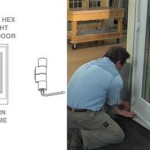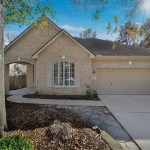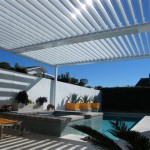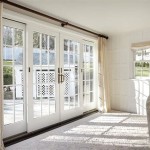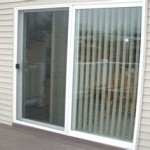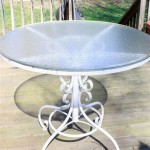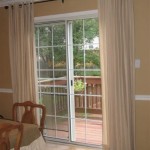Andersen Series 200 Patio Door: A Comprehensive Overview
The Andersen Series 200 patio door represents a mid-range offering within the Andersen Corporation's portfolio, designed to bridge the gap between their more economical options and their premium lines. It aims to deliver a balance of aesthetics, energy efficiency, and durability at a competitive price point. As such, it often appeals to homeowners seeking an upgrade from basic patio doors without the significant investment associated with top-tier products. This article provides a detailed examination of the Andersen Series 200 patio door, covering its features, benefits, material composition, performance characteristics, and considerations for installation and maintenance.
The Series 200 patio door is available in various configurations, including gliding (sliding) and hinged (French) styles. Gliding doors operate on a track system, allowing one panel to slide horizontally past a stationary panel. This design is well-suited for spaces where swing space is limited. Hinged doors, on the other hand, swing inwards or outwards like a traditional door, offering a more classic aesthetic. Both styles can be customized with different hardware finishes, grille patterns, and glass options to complement a variety of architectural styles.
One of the key defining factors of the Series 200 is its composite construction. The door frame and panels are primarily constructed using a wood composite material called Fibrex. Fibrex is a proprietary blend of wood fibers and thermoplastic polymers, offering a unique combination of strength, stability, and thermal performance. This construction distinguishes the Series 200 from all-vinyl or all-wood patio doors, each of which has its own distinct advantages and disadvantages.
Key Point 1: Fibrex Composite Material – Strength, Stability, and Thermal Performance
Fibrex is a central element in the overall performance and longevity of the Andersen Series 200 patio door. Its composition contributes significantly to its resistance to common issues that plague traditional wood or vinyl doors. Wood is susceptible to rot, insect infestation, and warping due to moisture exposure. Vinyl, while resistant to these issues, can be prone to expansion and contraction with temperature fluctuations, leading to potential air leaks and compromised structural integrity. Fibrex, by combining the properties of both materials, aims to mitigate these drawbacks.
The inclusion of wood fibers within the Fibrex composite provides inherent strength and rigidity, allowing for narrower frame profiles and larger glass areas. This contributes to a more aesthetically pleasing design and maximizes natural light infiltration. The thermoplastic polymers bind the wood fibers together and provide resistance to moisture, preventing rot and decay. This inherent resistance to the elements reduces the need for frequent painting or staining, minimizing maintenance requirements. Furthermore, the composite material provides improved thermal insulation compared to aluminum or traditional wood, contributing to energy savings.
The dimensional stability of Fibrex is another crucial aspect of its performance. Unlike vinyl, which can significantly expand and contract with temperature changes, Fibrex exhibits minimal expansion and contraction. This reduces the risk of air infiltration around the door frame and panels, contributing to enhanced energy efficiency and a more comfortable indoor environment. The stability also helps to maintain the integrity of the door’s seals and weatherstripping, preventing drafts and moisture intrusion.
Furthermore, Fibrex is an environmentally responsible material choice. Andersen utilizes reclaimed wood fibers in the manufacturing process, reducing the demand for virgin timber and minimizing waste sent to landfills. The durability of Fibrex also contributes to sustainability by extending the lifespan of the patio door, reducing the need for frequent replacements and minimizing environmental impact. The material's resistance to decay also eliminates the need for harsh chemical treatments often required for wood products.
Key Point 2: Energy Efficiency and Glass Options
Energy efficiency is a crucial consideration for modern patio doors, and the Andersen Series 200 addresses this requirement through its Fibrex construction and various glass options. The inherent insulation properties of Fibrex contribute to reduced heat transfer, minimizing energy loss during the winter months and preventing excessive heat gain during the summer. However, the glass selection plays an equally important role in determining the overall energy performance of the door.
Andersen offers a range of glass options for the Series 200 patio door, including Low-E (low-emissivity) glass. Low-E coatings are thin, transparent coatings applied to the glass surface that reduce the amount of ultraviolet and infrared light that can pass through. This helps to minimize heat gain and fading of interior furnishings. Different Low-E coatings are available, each designed to optimize energy performance for specific climates. For example, a Low-E coating designed for warm climates will prioritize solar heat gain reduction, while a Low-E coating designed for cold climates will focus on retaining heat within the home.
In addition to Low-E coatings, Andersen also offers options for double-pane and triple-pane glass. Double-pane glass consists of two panes of glass with an air or gas-filled space between them. This air space acts as an insulator, further reducing heat transfer. Triple-pane glass, with three panes of glass, provides even greater insulation and energy efficiency. While triple-pane glass offers the best performance, it also comes with a higher cost. The choice between double-pane and triple-pane glass will depend on the homeowner's budget and energy efficiency goals.
Other glass options include tinted glass, which reduces glare and solar heat gain, and laminated glass, which provides enhanced security and sound insulation. Laminated glass consists of two panes of glass bonded together with a layer of plastic, making it more resistant to shattering and forced entry. The combination of Fibrex frames and energy-efficient glass options contributes to the overall energy performance of the Andersen Series 200 patio door, helping homeowners to reduce their energy consumption and lower their utility bills.
Key Point 3: Design Flexibility and Customization
The Andersen Series 200 patio door offers significant design flexibility and customization options, allowing homeowners to tailor the door to their specific aesthetic preferences and functional requirements. This flexibility extends to the door style, hardware finishes, grille patterns, and interior and exterior colors.
As previously mentioned, the Series 200 is available in both gliding and hinged styles. This allows homeowners to choose the door style that best suits their needs and preferences. Gliding doors are ideal for spaces where swing space is limited, while hinged doors offer a more traditional and elegant look. Within each style, there are further options for panel configurations and sizes. For example, gliding doors can be configured with two, three, or four panels, while hinged doors can be single, double, or even feature sidelights.
Hardware finishes play a significant role in the overall appearance of the patio door. Andersen offers a variety of hardware finishes for the Series 200, including brushed chrome, satin nickel, oil-rubbed bronze, and white. These finishes can be selected to complement existing hardware and fixtures in the home. The hardware options extend to the handles, locks, and hinges, allowing for a cohesive and unified design.
Grille patterns are another element that can be customized to enhance the aesthetic appeal of the patio door. Grilles are decorative bars that are placed between the panes of glass, creating a divided-light effect. Andersen offers a range of grille patterns, including colonial, prairie, and custom designs. The grille pattern can be chosen to complement the architectural style of the home and add visual interest to the door.
The Series 200 also offers a variety of interior and exterior color options. The exterior color can be selected to match the home's siding or trim, while the interior color can be chosen to complement the interior decor. This allows for a seamless integration of the patio door into the overall design of the home. The combination of these design options provides homeowners with a high degree of control over the appearance of their Andersen Series 200 patio door, ensuring that it complements their specific style and enhances the beauty of their home.
Installation of the Andersen Series 200 patio door is a critical factor in its long-term performance. Proper installation ensures that the door operates smoothly, seals tightly against the elements, and provides optimal energy efficiency. It is generally recommended to have the door installed by a qualified professional who has experience with Andersen products. Improper installation can lead to issues such as air and water leaks, difficulty operating the door, and premature wear and tear.
Maintenance of the Andersen Series 200 patio door is relatively simple. Regular cleaning with a mild soap and water solution is typically sufficient to keep the door looking its best. The tracks of gliding doors should be cleaned periodically to remove any debris that could impede smooth operation. The weatherstripping around the door should be inspected regularly for any signs of damage or wear and tear and replaced as needed. Lubricating the hardware components, such as hinges and locks, can also help to ensure smooth operation and prevent corrosion. With proper care and maintenance, the Andersen Series 200 patio door can provide years of reliable performance and enhance the beauty and value of a home.

71 1 4 In X 79 2 100 Series White Left Hand Composite Gliding Patio Door With Interior And Hardware

Andersen 70 1 2 In X 79 200 Series White Left Hand Perma Shield Sliding Patio Door W Int Fixed Panel Blinds 9139500 The Home

71 1 4 In X 79 2 200 Series White Fiberglass Hinged Inswing Patio Door With Low E Glass And Interior

Perma Shield Gliding Patio Door Andersen Styles

Andersen 200 Series Permashield Patio Door 2 Panel Finelight Grills

70 1 2 In X 79 200 Series White Left Hand Perma Shield Gliding Patio Door With Interior Hardware

Andersen 200 Series Narroline Sliding Patio Doors In Atlantic Highlands

Andersen 200 Series Patio Doors

Andersen 70 1 2 In X 79 200 Series White Left Hand Perma Shield Gliding Patio Door With Interior Frame Kit 9122361 The Home

Andersen 200 Series Perma Shield Patio Door 2 Panel Windowrama

